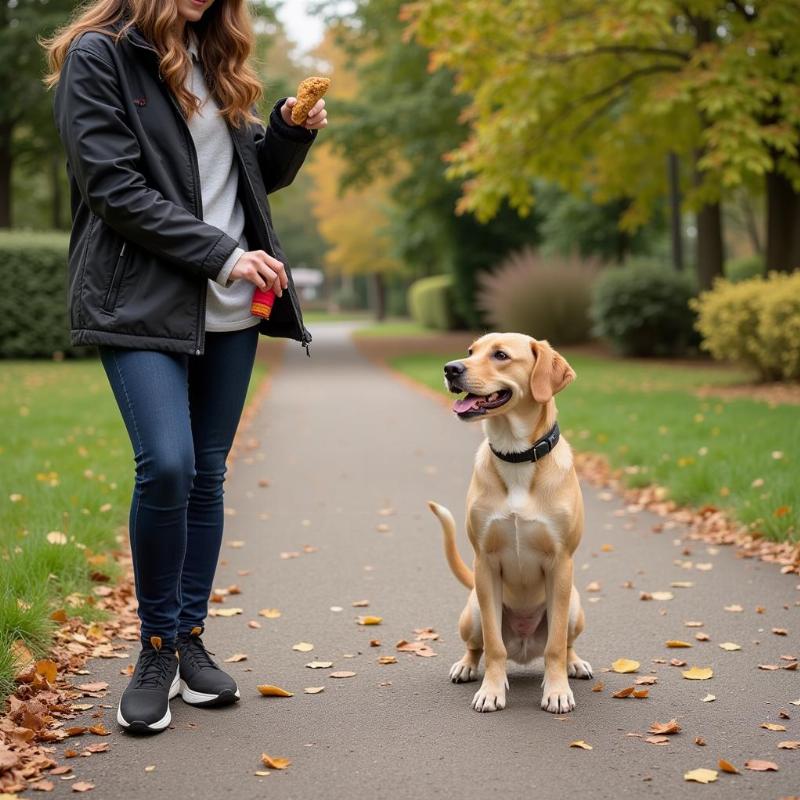The age-old question: should I feed my dog before or after a walk? It’s a common concern for dog owners in the US, and the answer isn’t always a simple one. Understanding your dog’s individual needs, breed, and potential health risks is crucial to making the right decision for their well-being. Feeding too close to exercise can lead to serious health issues like bloat, while waiting too long after exercise can also cause problems. Let’s explore the optimal feeding schedule related to walks to ensure your furry friend stays happy and healthy.
Understanding the Risks: Bloat and Other Digestive Issues
Bloat, or Gastric Dilatation-Volvulus (GDV), is a life-threatening condition that can occur when a dog’s stomach fills with gas and twists. This is more common in large, deep-chested breeds like Great Danes, German Shepherds, and Standard Poodles. While the exact cause of bloat is unknown, exercising too soon after eating is considered a significant risk factor. The movement can cause the stomach to flip, cutting off blood supply and requiring immediate veterinary intervention.
Smaller breeds can also experience digestive upset, vomiting, or regurgitation if exercised too soon after eating. Waiting at least an hour after feeding before a vigorous walk can significantly reduce these risks.
The Ideal Feeding Schedule Around Walks
The general rule of thumb is to wait at least an hour after feeding before taking your dog for a walk, especially a strenuous one. For smaller breeds and less intense walks, 30 minutes might suffice. Conversely, it’s generally recommended to wait about 30 minutes after a walk to feed your dog. This allows them to cool down and their digestive system to return to normal.
Tailoring the Schedule to Your Dog’s Needs
While these guidelines provide a good starting point, remember that every dog is an individual. Factors like age, breed, activity level, and specific health conditions can influence the ideal feeding schedule.
- Puppies and Senior Dogs: These dogs often benefit from smaller, more frequent meals. Adjust walk times accordingly, ensuring shorter waits between meals and walks.
- High-Energy Breeds: Active breeds like Border Collies and Australian Shepherds might require a longer period between eating and intense exercise.
- Dogs with Sensitive Stomachs: Consider a longer waiting period both before and after walks for dogs prone to digestive upset.
Dr. Emily Carter, DVM, a veterinarian specializing in canine digestive health in Austin, Texas, advises, “Always prioritize your dog’s individual needs. Observe their behavior after meals and walks. If you notice any signs of discomfort, adjust the timing accordingly.”
What If My Dog Begs for Food Before a Walk?
Some dogs may associate walks with food and beg incessantly before heading out. It’s essential to establish a routine and stick to it. Distract them with a toy or a short training session before the walk to break this association.
 Training a dog before a walk
Training a dog before a walk
Dr. Mark Johnson, DVM, a veterinary behaviorist in Denver, Colorado, suggests, “Consistency is key. If you establish a clear routine, your dog will eventually learn to expect food at the appropriate time, regardless of the walk.”
Should I feed my dog before or after a walk? – In Summary
Feeding your dog at the right time in relation to their walks is crucial for their digestive health and overall well-being. While the general rule is to wait an hour after feeding before a walk and 30 minutes after a walk before feeding, it’s essential to consider your dog’s individual needs. Always consult with your veterinarian if you have any concerns about your dog’s feeding schedule or digestive health.
FAQs
- What are the signs of bloat in dogs? Bloat symptoms include a distended abdomen, excessive drooling, restlessness, pacing, and attempts to vomit without producing anything.
- Can I give my dog treats on a walk? Small, low-calorie treats are generally fine, but avoid large or fatty treats, especially close to meal times.
- What should I do if my dog vomits after eating and exercising? Contact your veterinarian immediately.
- Is it okay to feed my dog right before a short potty break? A short potty break shouldn’t pose the same risks as a longer walk, but it’s still best to err on the side of caution, especially for at-risk breeds.
- How can I prevent bloat in my dog? Besides managing meal times around exercise, consider feeding smaller, more frequent meals, avoiding elevated food bowls, and providing access to fresh water at all times.
- Are there specific dog breeds more prone to bloat? Yes, large, deep-chested breeds like Great Danes, German Shepherds, and Standard Poodles are at higher risk.
- What type of exercise is safe after eating? Light activity like a slow walk or playtime in the yard is generally okay after a short waiting period, but avoid strenuous exercise like running or intense fetching.
Beautdogs.us is your premier online destination for comprehensive dog care information, breed insights, and product recommendations. We provide expert advice to help you navigate the world of dog ownership, whether you’re a seasoned owner or just starting your journey. From nutrition and grooming to training and health, Beautdogs.us is your trusted resource for all things canine. Contact us at [email protected] or +1 501-555-7529 for personalized support.